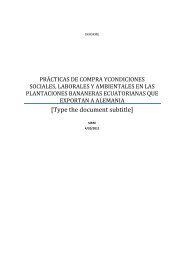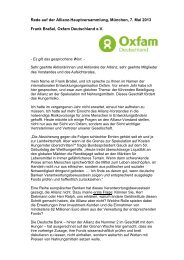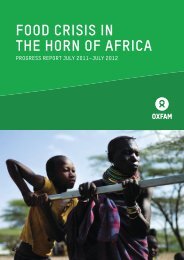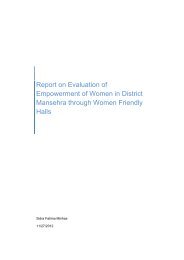No Time to Lose - Oxfam
No Time to Lose - Oxfam
No Time to Lose - Oxfam
Create successful ePaper yourself
Turn your PDF publications into a flip-book with our unique Google optimized e-Paper software.
‘The problem of killings<br />
by the police and other<br />
armed personnel acting<br />
under the authority of<br />
Government officials has<br />
been largely overlooked.<br />
… The technique is <strong>to</strong><br />
let time pass until the<br />
evidence has faded and<br />
other political concerns<br />
have claimed the limelight.<br />
The matter can<br />
then be quietly filed<br />
away.’<br />
Philip Als<strong>to</strong>n, Special<br />
Rapporteur on Extra-<br />
Judicial, Arbitrary or<br />
Summary Executions,<br />
Press Statement, May<br />
2008<br />
‘Caught in the crossfire’<br />
<strong>No</strong>t all civilian harm caused by the ANSF is caused in violation of international<br />
law. As in any armed conflict, civilians are caught in the<br />
crossfire and can be killed, injured or suffer property damage even<br />
when the conduct of military operations accords with international<br />
humanitarian law. In 2010, 171 civilians were killed in air strikes<br />
launched by international forces, and 45 in ‘escalation of force incidents’<br />
(international and/or national forces shooting at suspected attackers)<br />
67 – attacks which may or may not have been carried out in<br />
compliance with the rules of international law regarding the conduct<br />
of hostilities. Statistics do not distinguish between civilians killed by<br />
national and international military forces; however given the ANSF’s<br />
relative lack of competency and professionalism, and the lack of<br />
mechanisms in place for minimising civilian harm, there is a serious<br />
concern that as the ANSF assume greater responsibility for combat<br />
operations the number of civilians caught in the crossfire could increase.<br />
Lack of Accountability<br />
Community resentment over violations of human rights and humanitarian<br />
law by the ANSF, as well as resentment caused by incidental<br />
civilian harm caused during lawful combat operations, is exacerbated<br />
by what is perceived <strong>to</strong> be an overwhelming lack of accountability.<br />
Key issues include ambiguous and non-transparent chains of command<br />
(meaning that community members are often unable <strong>to</strong> identify<br />
which forces were responsible for alleged misconduct); a lack of public<br />
awareness regarding how or where <strong>to</strong> lodge a complaint; a fear of<br />
retaliation; slow or non-existent investigation and response; the fact<br />
that even when investigations are conducted the findings are often not<br />
made public; and a consistent failure <strong>to</strong> provide apology, compensation<br />
or redress.<br />
Following the night raid in Paktia province, discussed above, the bodies<br />
of the victims were carried through <strong>to</strong>wn in protest. The MoI and<br />
ISAF announced that a joint investigation was underway, but the<br />
findings of the investigation have not been published. 68 In the case of<br />
the young girl killed by the ANA in Herat, the corps commander initially<br />
refused <strong>to</strong> initiate an investigation, and the alleged perpetra<strong>to</strong>r<br />
was assisted <strong>to</strong> flee the area. An investigation was finally initiated<br />
under pressure from the ANA’s legal advisors, but there has been no<br />
investigation in<strong>to</strong> the attempted cover up. 69 Following the incident in<br />
Ghor, the AIHRC lodged a complaint with the MoI, but was informed<br />
that the authorities were unable <strong>to</strong> investigate the incident due <strong>to</strong> insecurity<br />
in the province. 70 Following the incident in Tirin Kot, the UN<br />
pursued the incident both with the provincial chief of police and the<br />
15







![Download: Faltposter EU-Handelspolitik [PDF 2,17MB] - Germanwatch](https://img.yumpu.com/25095854/1/190x161/download-faltposter-eu-handelspolitik-pdf-217mb-germanwatch.jpg?quality=85)








